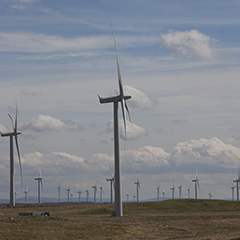The Scottish Government has approved ScottishPower plans for the UK’s largest windfarm, Whitelee, to have its own purpose built super battery on site, in what will be one of the biggest battery projects in the UK.
Charged with clean green renewable power from the site’s 215 turbines, the planned battery storage centre will support the National Grid in maintaining the resilience and stability of the electricity grid, even at times when the wind may not be blowing – a first for a windfarm in the UK at this scale.
The battery storage site will be the size of half a football pitch and will comprise 50MW of lithium-ion battery technology, which is the most cost-effective storage technology for renewable electricity.
Its planned storage capacity makes it the largest windfarm battery in the UK, capable of achieving full charge in less than an hour. This means it will be on standby to provide services like reactive power and frequency response to National Grid, enhancing control and flexibility. The battery can be fully discharging or used in bursts as and when required to keep the electricity network stable by balancing supply and demand.
The battery will also enhance the capability of storing excess energy from wind generation at times when demand is low or wind is high – for instance at night, and released at time of high demand and lower wind.
Keith Anderson, ScottishPower Chief Executive, said: “This is a significant step forward in the road to baseload for renewable energy.
“We know that renewable energy generation needs to quadruple and we know that onshore wind is the cheapest form of green energy.
“By integrating storage technologies with onshore wind, we are blowing away one of the myths about renewable generation not being available when you need it. Natural resources like wind and solar are variable in their very nature, and by using a battery we can ensure we optimise our ability to use the resource most effectively. This is another step forward by ScottishPower in investing clean, green and flexible generation to fully displace historic fossil fuel generation.
“If we are to meet the bold target of net zero by 2050 and deliver the decarbonisation of our economy, transport and heating systems, large battery storage facilities such as this along with more windfarms like Whitelee are crucial.”
Local planning permission for the battery storage facility was granted by South Lanarkshire Council in May with Scottish Ministers rubber stamping the proposal on Monday 10th June.
The battery facility will be constructed on vacant land within the Ardochrig substation compound which lies to the eastern edge of the existing windfarm site, allowing for a straightforward connection to the grid, thereby optimising the existing infrastructure arrangements.
Installation work is expected to start early next year with the facility fully operational by the end of 2020.
ScottishPower operates Whitelee along with almost 40 windfarms around the UK, is also seeking to put similar arrangements in place at many of its other windfarms, with potential for batteries to go onto solar and future wind sites too.
- Whitelee Windfarm is the UK’s largest onshore windfarm, located on Eaglesham Moor just 20 minutes from Glasgow. Owned and operated by leading wind energy developer ScottishPower, its 215 turbines range up to 140m in height and have been successfully providing clean green renewable energy for almost a decade. Its significance to Scotland and its contribution to achieving ambitious climate change targets cannot be underestimated. At peak, it can generate 539 megawatts of electricity, enough to power just under 300,000 homes* or all the households in Glasgow.
*298,837 homes per year based on the expected average capacity factor of 27% and an average annual domestic electricity usage of 4,266kWh - Baseload is the minimum level of demand on an electrical grid over a span of time, for example, one week. This demand can be met by unvarying power plants, such as large coal or nuclear plants – generally known as baseload power plants. As renewable technologies are intermittent, generating when natural resources are available, they have been less likely to be classed as ‘baseload’ given demand and supply are more challenging to balance.


























